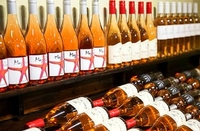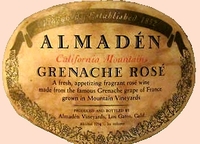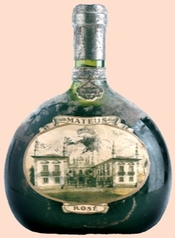 season for enjoying fine rosé wines is upon us. Fine rosés have been enjoyed by winedrinkers of the Mediterranean countries for centuries. On their home ground, these elegant rosé wines are recognized as a perfect beverage for summer weather and summer foods. While Europeans have been enjoying flavorful, refreshing pink wines with their summer repasts, until the last decades these excellent food companions were virtually ignored by the American wine consumer.
season for enjoying fine rosé wines is upon us. Fine rosés have been enjoyed by winedrinkers of the Mediterranean countries for centuries. On their home ground, these elegant rosé wines are recognized as a perfect beverage for summer weather and summer foods. While Europeans have been enjoying flavorful, refreshing pink wines with their summer repasts, until the last decades these excellent food companions were virtually ignored by the American wine consumer.
The history of rosé in the modern US wine market shows that while it has long existed on the fringe of accepted fine wines, it has often found great acceptance  in the popular taste. In Julian Street’s post-prohibition 1933 book “Wines” he mentions only that rosés existed in France and were seldom exported. By 1956, Philip M. Wagner’s book, “American Wine & Wine-Making” spoke of the pioneering success of Almadén’s Grenache Rosé from grapes grown in the Santa Clara Valley. In the 1960’s and 1970’s Mateus Rosé from Portugal became very popular and spawned competing brands of slightly to moderately sweet and often fruit-flavored rosés like Lancers, Annie Green Springs and Boone’s Farm.
in the popular taste. In Julian Street’s post-prohibition 1933 book “Wines” he mentions only that rosés existed in France and were seldom exported. By 1956, Philip M. Wagner’s book, “American Wine & Wine-Making” spoke of the pioneering success of Almadén’s Grenache Rosé from grapes grown in the Santa Clara Valley. In the 1960’s and 1970’s Mateus Rosé from Portugal became very popular and spawned competing brands of slightly to moderately sweet and often fruit-flavored rosés like Lancers, Annie Green Springs and Boone’s Farm.
About this time, in 1972, Bob Trinchero of Sutter Home Winery was experimenting with ways to make his Deaver Vineyard Zinfandel richer. To concentrate the red wine, he drew off some of the free-run juice before  fermentation to increase the skin to juice ratio of the red wine. The question then became what to do with the pale colored juice. Initially, he made it into a dry wine called “Oeil de Perdrix” or “Eye of the Partridge.” The BATF required an English translation on the label, so he called it a “A White Zinfandel Wine.” However, the fermentation of the 1974 wine stopped before it was fully dry – a winemaker’s nightmare of a stuck fermentation. After setting the batch aside for a few weeks, Trinchero tasted it again and found it deliciously sweet, balanced, and pink. He bottled it in 1975 and the White Zinfandel rage was born with Sutter Home alone selling 4.5 million cases per year at its peak. Throughout the 1980’s and 1990’s White Zinfandel filled shelves around the country with pink wines.
fermentation to increase the skin to juice ratio of the red wine. The question then became what to do with the pale colored juice. Initially, he made it into a dry wine called “Oeil de Perdrix” or “Eye of the Partridge.” The BATF required an English translation on the label, so he called it a “A White Zinfandel Wine.” However, the fermentation of the 1974 wine stopped before it was fully dry – a winemaker’s nightmare of a stuck fermentation. After setting the batch aside for a few weeks, Trinchero tasted it again and found it deliciously sweet, balanced, and pink. He bottled it in 1975 and the White Zinfandel rage was born with Sutter Home alone selling 4.5 million cases per year at its peak. Throughout the 1980’s and 1990’s White Zinfandel filled shelves around the country with pink wines.
The rise of finer dry rosés began in the early 1990’s, influenced by advances in winemaking technology. Before the days of temperature-controlled fermentation, making attractive rosé wines was very difficult, since oxidation turned an attractive and vibrant pink color to a faded orange-brown. Although color is not the only aspect of rosé that is attractive, it is very important for consumer impressions. Fine rosé wines have finally made a big impact in the market in the last ten years or so, thanks to modern winemaking technology and consumer recognition that rosé is more than simple and sweet. Rosés from all over the world now populate retail shelves, to the great benefit of wine consumers.
Rosé wine can be made in several ways. The easiest is perhaps simply blending white and red wines to the desired hue. This might seem like the most obvious method of making rosé, but the practice of blending red and white wine after fermentation is not allowed in most areas of the EU. Champagne is a notable exception because the long bottle-aging process can have a detrimental effect of the color of rosé Champagne.
The most common method of making quality rosé is to allow the unfermented red grape juice, or must, to age on the skins for a limited time. The color pigments of almost all red grapes is in the grape skins, and red wines are made by leaving the skins in contact with the must to extract color for days or weeks. For rosé production, however, the skins are in contact with the juice for anywhere from a few hours to a day or two, depending on the pigment content of the grapes and the desired color for the finished wine. In some instances, the must will be separated immediately from the skins, resulting in the palest color rosés.
Another way to make rosé is call the saignée method – the source of the original White Zinfandel. Saignée literally means “bleeding” and the process evolved from red wine making. In order to concentrate the color and intensity of red wines, it became customary to “bleed” a percentage of grape must from the total volume. This resulted in deeper and richer red wines. It also gave rise to the making of rosé wines from the removed must. While saignée rosés were originally dismissed as a low-quality byproduct of red wine making, many producers today use the saignée method to ensure quality juice for their rosé wines.
Rosé production has been a boon for many wineries. In a business where producers traditionally age their wines for a year or more before release (and income), the quick turn to market of rosé wines provides welcome cash flow. Also, vineyard sites in cooler areas that are unable to ripen grapes sufficiently for red wine production, become viable for rosé wine growing.
Arguably most distinctive rosé wines come from the Mediterranean nations. The southern French vineyards produce the legendary rosé wines of Bandol, Tavel, Lirac, and the Côtes de Provence. These wines are made largely from the same grapes that are used in red wine production – the Grenache, Mourvèdre, Cinsault and Carignan. At their best, these wines can exhibit a panoply of fresh strawberry, raspberry, cherry, pear and apple fruit scents along with subtleties of flowers, dried herbs, cinnamon, clove and nutmeg. Other sources of French rosé wines are the Cabernet Franc-based wines from Anjou and Touraine in the Loire Valley, the Pinot Noir-based rosés from Sancerre in the Loire and Marsannay in Burgundy, and the fine array of spicy rosés that spring from the wide-ranging vineyards of Languedoc-Roussillon.
Spain is another source of excellent rosé wines. Try a bottle of rosado from Navarra or Rioja to experience the juicy strawberry fruit and subtle spiciness that marks these wines. Italy, too can provide bright and lively rosato and chiaretto wines. Even Piedmont producers of Barolo and Barbaresco are often now offering rosé wines from Nebbiolo and other grapes. Throughout the rest of Europe, including Germany, Austria, Portugal, Greece and beyond, producers are sending fine rosés to the market.
There are as well more good rosés made in the U..S., from many grape varieties. Pinot Noir, Grenache, Mourvèdre and Syrah are all used for quality California rosé production. Oregon Pinot Noir producers frequently now offer a rosé of Pinot Noir as well as their well-known red wines. Many producers of dry rosés label their wines as vin gris (literally “grey wine”) to give them a unique standing in the market.
The most endearing characteristic of dry rosés is their remarkable versatility in accompanying a wide range of foods. When shopping for rosés, keep in mind that freshness is a key consideration. A good rosé is almost invariably at its best when bursting with the exuberant fruit of youth. So look for the most current vintage, preferably within a year of the current date. I will admit that some rosé wines can age for a few years if not more, I do not generally agree they are better wines for the aging. Champagne is a notable exception.
Match a southern French rosé bottling with a traditional Provençal dish — bouillabaise, salade niçoise, tapenade, ratatouille. and anything with garlic aioli. You’ll find that what grows together, goes together. Warmer weather means grilling season and what better accompaniment than a refreshing rosé. Grilled salmon, halibut, as well as other fish and shellfish can be matched by a fuller-bodied rosé. Additionally, grilled sausages and red meats can pair well with a good rosé with just a touch of chill to offset the warmth of the day. As a long-time rosé lover, I eagerly await the new arrivals. I hope you will check them out as well.
